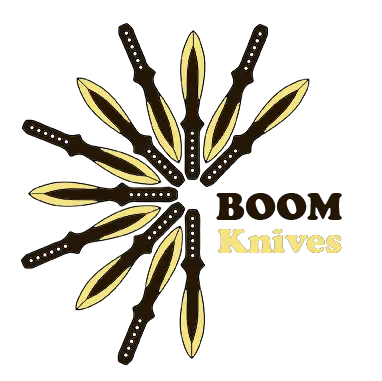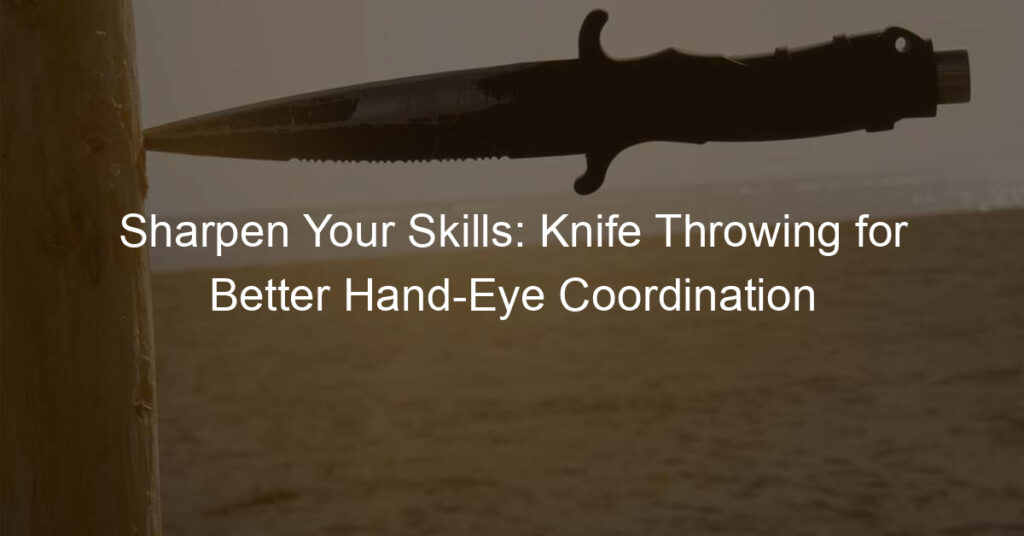Introduction to Knife Throwing
This ancient art form requires precision, focus, and a deep understanding of the tools at hand. Whether you’re a beginner or an experienced thrower, there’s always something new to learn. Let’s dive in!
-
- Understanding the basics of knife throwing
Knife throwing is a skill that involves accurately tossing a knife so that it hits and sticks into a target. It’s not just about strength; it’s about technique. The thrower must understand the weight and balance of the knife, the distance to the target, and the rotation of the knife in the air. It’s a combination of physics, body mechanics, and mental focus.
-
- Why learn knife throwing?
It’s a fun and unique hobby that can be a great way to relieve stress. It can also be a competitive sport, with competitions held around the world. Plus, it’s a skill that can come in handy in survival situations. But perhaps the most compelling reason is the sense of accomplishment and confidence that comes from mastering a challenging skill.
-
- Historical background of knife throwing
It’s been used for hunting, warfare, and entertainment for thousands of years. The ancient Egyptians, Greeks, and Romans all practiced knife throwing. In the Middle Ages, it was a popular sport among knights. In the Wild West, it was a staple of traveling shows. Today, it’s enjoyed by people all over the world, both as a hobby and a competitive sport. You can learn more about the history of knife throwing on Wikipedia.
Knife Throwing Basics for Beginners
Your First Throwing Knife
-
- Types of throwing knives
There are three main types of throwing knives: balanced knives, blade-heavy knives, and handle-heavy knives. Balanced knives are the most recommended for beginners as they are easier to handle and throw consistently. Blade-heavy and handle-heavy knives require more skill and experience to use effectively.
-
- What to look for in a throwing knife
When choosing a throwing knife, consider its weight, length, and material. A good throwing knife should be heavy enough to ensure a stable flight, but not so heavy that it’s difficult to throw. The length should be between 12 to 16 inches for beginners. As for the material, stainless steel is a popular choice due to its durability and resistance to rust.
-
- Recommendations for beginners
Stainless steel throwing knife that is between 12 to 16 inches in length. Some popular choices include the Smith & Wesson SWTK8CP Six 8in Stainless Steel Throwing Knives and the Perfect Point RC-595-3 Thunder Bolt Throwing Knife.
Understanding Knife Throwing Techniques
-
- The Grip
It’s how you hold the knife. There are several ways to grip a throwing knife, but the most common one for beginners is the hammer grip. This grip is named so because you hold the knife as if you were holding a hammer. The handle rests in your palm with your four fingers on one side and your thumb on the other. This grip provides a good balance between control and ease of release. A firm grip is essential, but don’t squeeze the handle too hard. You want the knife to release smoothly from your hand.
-
- The Stance
A proper stance provides balance and stability, which are crucial for a successful throw. Stand with your feet shoulder-width apart, with your non-throwing foot slightly ahead of your throwing foot. Your body should be facing the target. Keep your back straight and relax your shoulders. This stance will give you a solid foundation for your throw.
-
- The Throw
It involves a coordinated movement of your arm and wrist. Start with your throwing arm extended back, then swing it forward in a smooth, controlled motion. Release the knife when your arm is fully extended towards the target. The key to a successful throw is consistency. Practice the same motion over and over until you can do it without thinking.
Advanced Knife Throwing Techniques
Mastering Different Throwing Styles
-
- Spin Throwing
It involves throwing the knife in such a way that it spins in the air before hitting the target. This technique requires a good understanding of distance and rotation. The key to mastering spin throwing is to ensure that the knife completes a full rotation before it hits the target. This can be achieved by adjusting the force and angle of your throw based on the distance of the target.
-
- No-Spin Throwing
As the name suggests, involves throwing the knife in such a way that it does not spin in the air. This technique is more difficult to master than spin throwing, but it can be more accurate and effective once you get the hang of it. The key to no-spin throwing is to release the knife smoothly and to keep your wrist rigid during the throw.
-
- Half-Spin Throwing
In this technique, the knife makes a half rotation before hitting the target. This technique can be a bit tricky to master, but it offers a good balance of speed and accuracy. The key to half-spin throwing is to adjust your grip and release point based on the distance of the target.
Training for Accuracy and Precision
-
- Practice Routines
Establish a routine that allows you to practice regularly. Start with a close target and gradually increase the distance as your accuracy improves. It’s not about how fast you can throw, but how accurately you can hit your target. A good practice routine could involve throwing 100 times a day, five days a week.
-
- Tips for Improving Accuracy
Ensure you have a proper grip on the knife. Your grip should be firm but relaxed. Second, focus on your target. Visualize the path your knife needs to take to hit the target. Lastly, maintain a consistent throwing motion. The more consistent your throw, the more accurate you will be.
-
- Common Mistakes and How to Avoid Them
Include inconsistent grip, poor stance, and lack of focus. To avoid these, always ensure your grip is firm and consistent. Your stance should be balanced and comfortable. And most importantly, always keep your eyes on the target. So, don’t be discouraged by initial failures. Learn from them and keep practicing.
Training for accuracy and precision in knife throwing requires dedication, practice, and a keen understanding of common mistakes. With consistent practice and the right techniques, you can master the art of knife throwing.
Professional Knife Throwing
Competing in Knife Throwing
-
- Understanding competition rules
These rules may include the type of knives to be used, the distance from the target, and the scoring system. It’s crucial to familiarize yourself with these rules before participating in a competition. You can find more information about the rules of professional knife throwing on the Wikipedia page.
-
- Preparing for a competition
Physically, you need to practice your throwing techniques and ensure your aim is accurate. Mentally, you need to prepare yourself to handle the pressure of the competition. Regular practice, a healthy diet, and a good sleep schedule can help you prepare for a competition.
-
- Case study: A day in the life of a professional knife thrower
Let’s look at a day in the life of a professional knife thrower. John, a professional knife thrower, starts his day with a healthy breakfast followed by a few hours of practice. He then spends some time studying the techniques of other professional throwers to improve his skills. In the afternoon, he exercises to maintain his physical fitness. In the evening, he practices throwing at different distances to prepare for various competition scenarios. This case study shows that becoming a professional knife thrower requires dedication, discipline, and continuous learning.
Building a Career in Knife Throwing
- Turning a Hobby into a Profession
Knife throwing, like any other sport, requires dedication, practice, and a deep understanding of the craft. If you’re already a hobbyist, you’ve taken the first step towards a professional career. The next step is to take your skills to the next level. This can be achieved through regular practice, attending workshops, and participating in local competitions. Every professional was once a beginner. With passion and perseverance, you can turn your hobby into a rewarding career.
- Networking in the Knife Throwing Community
joining local clubs, participating in competitions, and engaging in online forums can help you connect with like-minded individuals. These connections can provide valuable advice, support, and opportunities. A great place to start is the International Knife Throwers Hall of Fame, which offers resources and a community for knife throwers of all levels.
- Key Takeaways from Successful Professional Knife Throwers
-
- Consistent practice is key to improving your skills.
- Never stop learning. Even the most experienced throwers continue to learn and adapt their techniques.
- Patience and perseverance are crucial. Success may not come immediately, but with time and effort, you can achieve your goals.
Conclusion: The Path to Knife Throwing Mastery
-
- Recap of knife throwing basics, techniques, and professional insights
We started with the basics, understanding the different types of knives and the correct way to hold and throw them. We then moved on to advanced techniques, such as the no-spin throw and the underhand throw. We also gained insights from professional knife throwers, who shared their experiences and tips for success. For more detailed information, you can revisit the sections on Knife Throwing Basics for Beginners, Advanced Knife Throwing Techniques, and Professional Knife Throwing.
-
- The importance of continuous learning and practice
As with any skill, mastery in knife throwing comes with continuous learning and practice. Even the most successful knife throwers started as beginners. They became masters through consistent practice, learning from their mistakes, and never giving up. So, keep practicing, stay patient, and you will see improvement over time.
Lastly, for those aspiring to become masters in knife throwing, these key tips: always prioritize safety, practice regularly, and don’t be afraid to seek guidance from professionals.







